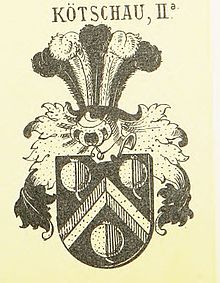Kötschau (noble family)
The name von Kötschau is shared by three different aristocratic families that were based in the Merseburg area.
history
There are three different unrelated families with different coats of arms. They are constantly mixed up in literature and mistaken for families of related names.
The individual origins of the families are not known.
For the first time a Cumbertus and his brother Henricus de Cotsowe (Gumpert and his brother Heinrich von Kötzschau) were mentioned as witnesses according to a document in the Altenburg document book of July 21, 1172 of the Emperor Friedrich I about the protection of the Pegau monastery . This is also the first mention of the place name Kötzschau . In 1174 Henricus de Cocsouhe appears again as a witness for a donation from the Merseburg bishop to the Pegau monastery. 1183 gave Henricus de Kotisowe and 1205 Albertus de Cotzowe the Altzella (in Nossen) more hooves country. Thereafter, from 1230 to 1244, a younger Gumpert de Kozowe was a canon and in 1234 a Lampertus de Cozowe was a canon of the Naumburg cathedral chapter .
Kotzschen, also written Kötschau
sat on Geiselröhlitz , Neumark, Klobichau , Etzelshayn and Obhausen. It is not certain whether the place of origin here Kötzschen, a district to the west of Merseburg , is an option.
coat of arms
The family kept a silver, slanted right-hand bar on red with three green linden leaves upwards. Ten black cock feathers on the helmet. The blankets are red and silver. They were related to the arms of Zweimen . A tribal relationship has not yet been proven. The line on Mittelröhlitz led a running ram in the diagonal right-hand bar. A ram growing on the helmet. Deviating from this, a seal from 1419 shows three arrowheads and a seal from 1470 shows three bells or rams in the diagonal right-hand bar.
from Kötschau
According to Johann Heinrich Zedler, it is the family that comes from Kötzschau. Unfortunately there are also mistakes in its description. From 1430 to 1718 Schafstädt was their family estate, with which they were enfeoffed in 1448 by Merseburg Bishop Johannes von Bose († 1463). Her other ancestral estate was Körbisdorf . They had other goods in Langeneichstädt , Dölkau , Oberschmon , Ilmersdorf, Piskaborn and Soolgüter zu Groß Salze.
coat of arms
They led a black wolf's head on blue with a bloody neck cut off. The motif on the helmet. The blankets are blue and silver.
Name bearer
- Emanuel Friedrich von Kötzschau (1666–1736), Danish Oberlanddrost of the county of Delmenhorst
written by Kötschau, also Közschau, Kötschemer
They were lords of Groß-Dölzig from 1467 to 1565, of the Klein-Dölzig manor from 1489 and 1530, Klein Lauchstedt, Kriegstedt until the 15th century and Bündorf Castle.
coat of arms
The sex led a white chevron on blue, which is accompanied by three golden apples. A peacock's tail on the helmet. The blankets are blue and silver. The branch of the family, which turned to Buttlar Castle in Fuldaische , had a black shield with a rafter divided by gold and red across the corner, accompanied by two apples at the top and an apple split by gold and red at the bottom. Five ostrich feathers alternating black and gold on the helmet. The helmet covers are black and gold.
literature
- Franz Oscar Pfeil: Chronicle of the village Kötzschau in the district of Merseburg , in: New communications from the field of historical-antiquarian research, Vol. 22 (1906), pp. 122–127
- Siebmacher coat of arms books, extinct Prussian nobility of the province of Saxony
- Clemens Freiherr von Hausen: vassal families of the Margraves of Meißen, Landgraves of Thuringia and Dukes of Saxony up to the beginning of the 17th century , in: Der Deutsche Herold. Quarterly magazine for heraldry, sphragistics and genealogy, 1890 p. 188 and 1892, p. 210
- Descriptive representation of the older architectural and art monuments of the Province of Saxony and adjacent areas , by the Historical Commission for the Province of Saxony and the Duchy of Anhalt, Volume 8, Halle 1883, pp. 70–71
- Valentin König : Genealogical aristocratic history or gender description of those in Chur-Saxon and neighboring countries […] oldest and most handsome noble families and […] high-counts' houses , 2nd part, page 762; Part 3, pp. 282, 572, 711-766, 927
- Johann Friedrich Gauhe: Of salvation. Rom. Reich's genealogical-historical nobility lexicon: in it the oldest and most handsome noble, baronial and count families, which are flourishing today, according to their antiquity and origin, 1st part, column 817
- Köthschau or Kotzschau, Kötzaw, Ketzschau, Kötzschau. In: Johann Heinrich Zedler : Large complete universal lexicon of all sciences and arts . Volume 15, Leipzig 1737, column 1391-1395.
- Otto Küstermann : Ancient geographic and topographic forays through the Merseburg Monastery . In: Neue Mittheilungen from the field of historical-antiquarian research, Volume 17, 1889, pp. 423-425
- Leopold Nedopil: German nobility samples from the German Order Central Archive , Volume 1, 1868, pp. 487, 498
- Damian Hartard von und zu Hattstein : The Highness of the Teutschen Reichs Nobility , Volume 1, 1751, p. 347
- Ernst Heinrich Kneschke : New General German Adelslexicon , Vol. 5, 1864 digitized
- Ernst Heinrich Kneschke: The coats of arms of the German baronial and noble families , 4th volume, Leipzig 1857, p. 230-231
Web links
- Bibliography in the Wildenfels Castle Archives


